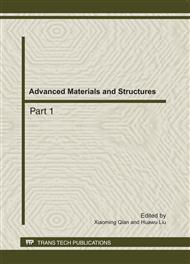[1]
Wang, J. & Wang, W. (1999). Nature structural biology. 6,1033-1038.
Google Scholar
[2]
Xia, X. & Li, W.(1998). J.Mol.Evol.47,557-564.
Google Scholar
[3]
Murphy, L.R., Wallqvist, A. & Levy, R. M. (2000). Protien Engineering. 13,148-152.
Google Scholar
[4]
Li, T., Fan, K., Wang, J. & Wang, W. (2003). Protein Engineering. 16, 323-330.
Google Scholar
[5]
Kosiol, C., Goldman, N. & Buttimore, N. H. (2004). Journal of Theoretical Biology. 228, 97-106.
Google Scholar
[6]
Dayhoff, M.O., Barker, W.C. & Hunt, L.T. (1983). Methods Enzymol. 91,524-545.
Google Scholar
[7]
Solis, A. D. & Rackovsky, S. (2000). Proteins: Struct. Funct. Genet. 38, 149-164.
Google Scholar
[8]
Cannata, N., Toppo, S., Romaldi, C., & Valle, G., (2002). Simplifying amino acid alphabets by means of a branch and bound algorithm and substitution matrices. Bioinformatics 18, 1102-1108.
DOI: 10.1093/bioinformatics/18.8.1102
Google Scholar
[9]
Sun, S.(1993). Reduced representation model of proteinal and genetic algorithms. Protein Sci. 2,762-785.
Google Scholar
[10]
Samudrala,R., Pedersen, J., Zhou, H., Luo, R., Fidelis, K. & Moult, J.(1995) Confronting the problem of interconnected structural changes in the comparative modeling of proteins. Protein: Struct .Funct. Genet. 23,327-336.
DOI: 10.1002/prot.340230307
Google Scholar
[11]
Taylor, W.R. (1986). The classification of amino acid conservation. J. Theor. Biol. 119, 205-218.
Google Scholar
[12]
Cieplak, M., Holter, N. S., Maritan, A. & Banavar J.R. (2001) J.Chem.Phys. 114,1420-1423.
Google Scholar
[13]
Murphy, L. R., Wallqvist, A. & Levy, R. M. (2000) Protein Eng., 13, 149-152.
Google Scholar
[14]
Miyata,T., Miyazawa,S. & Yasunaga,T. (1979) J.Mol.Evol., 12, 219-236.
Google Scholar
[15]
Risler, J. L., Delorme, M.O., Delacroix, H. & Henaut, A. (1988). J.Mol.Biol., 204,1019-1029.
Google Scholar
[16]
Wang, J and Wang, W. (2000) Phys. Rev. E, 61,6981-6986.
Google Scholar
[17]
Santibanez, M. and Rohde,K.(1987) CABIOS,3,111-114.
Google Scholar
[18]
Grantham,R. (1974). Amino acid difference formula to help explain protein evolution. Science . 185, 862-864.
DOI: 10.1126/science.185.4154.862
Google Scholar
[19]
Sinha, N. & Nussinov, R. (2001) Proc. Natl Acad. Sci. USA, 98, 3139-3144.
Google Scholar
[20]
Regan, L. & Degrado, W. F. (1988) Science, 241,976-978.
Google Scholar
[21]
Kamtekear, S., Schiffer, J.M., Xiong, H., Babik J.M. & Hecht, M. H. (1993) Science, 265,1680-1685.
Google Scholar
[22]
Davidson, A.R., Lumb K.J. & Sauer, R. T. (1995) Nat. Struct. Biol. 2, 856-863.
Google Scholar
[23]
Riddle, D.S., Santiago J.V., Bray, S.T., Doshi,N., Grantcharova, V.P., Yi,Q. & Baker,D.(1997) Nat. Struct. Biol. 4,805-809.
DOI: 10.1038/nsb1097-805
Google Scholar


